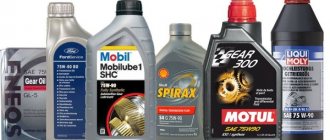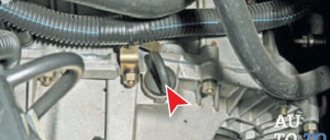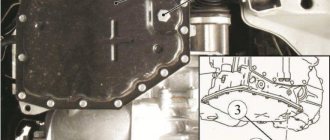The automatic gearbox is the most important and expensive component in a modern car after the engine. To ensure proper movement of the vehicle and stable operation of the device, it is necessary to promptly change the oil in the automatic transmission. Untimely maintenance can damage this unit, which can lead to expensive repairs. In this review we will tell you how, why and why you need to change this technical fluid in the box.
How does oil work in an automatic transmission?
First, let’s remember the principle of operation of the “automatic machine” in a car. This device connects the engine and wheels of the car, converting the torque of the power unit into the energy necessary for movement. In an automatic transmission, the engine crankshaft is connected to a torque converter (GDT), the output shaft of which works with the transmission mechanisms. The latter set the wheels of the car in motion.
Transmission oil, ATF (Automatic Transmission Fluid), is required for the following reasons:
- Ensures normal operation of the node. It transmits torque evenly to the transmission. Thanks to him, the car moves without jerking and smoothly. ATF acts as a kind of clutch pedal in an automatic transmission. The oil uses its body to activate the torque converter parts.
- Actuating mechanism. Having received a command from the ECU (electronic control unit), ATF exerts pressure on certain channels in the device (hydraulic plate), thereby changing gears.
- Removes heat. As a result of the operation of the mechanisms, the metal heats up. Transmission fluid (oil) removes heat into the crankcase, thereby stabilizing the operation of the device.
- Lubrication function. The metal parts of the gearbox are in constant motion, interacting with other components of the unit. They require constant lubrication. This increases their service life, reduces wear, and improves adhesive properties. ATF acts as a lubricant.
- Removal of waste product. When the mechanism operates, metal debris inevitably forms: dust, burrs, shavings, etc. Oil, with the help of additives added to it, helps the device get rid of unnecessary accumulation, facilitating the operation of the mechanisms.
The purpose of the transmission fluid may vary depending on the type of gearbox installed. In a robotic box, for example Getrag 6DCT250, it is necessary for cooling and lubrication of the gearbox. The remaining components of the device are cooled by air.
How to drain oil from an automatic transmission
The main difficulty when changing ATF fluid in an automatic transmission is draining the waste. Unlike a manual transmission, there is a complex hydraulic unit with a torque converter, containing many narrow channels inside for oil circulation.
With most methods, it will be possible to drain the waste only partially, and only a complete hardware replacement will remove the old transmission fluid without any residue.
But, regardless of the chosen method, you will need to drain the waste from the pan. Let's consider the procedure and existing options.
Popular brands:
Hyundai Santa Fe, Mitsubishi Pajero, Skoda Octavia
Draining oil through the plug
The easiest way. If your car has a drain plug on the automatic transmission housing, then:
- Drive the car 5 km to warm up the engine and transmission.
- Place the car on a pit, overpass or lift.
- Prepare a bucket or cut canister with a capacity of at least 5 liters.
- Unscrew the drain plug with a wrench (usually a tetrahedron). Unscrew it further with your hands, holding it from the side and not from the bottom.
- Abruptly remove your hand with the stopper, exposing the container.
- When the waste has finished dripping, the old oil is considered almost drained - you will also need to dismantle the pan and filter.
Draining used oil through the drain hole
Draining oil through the dipstick
There are cars where the drain plug is not provided. Changing the oil in an automatic transmission is possible here by pumping out the old ATP through a channel with a dipstick. To do this, use a transparent tube from a dropper, purchased at a pharmacy. Remove the dipstick and insert the tube in its place. Lower it to the very bottom of the tray. Attach the free end from the outside to the syringe. The larger the capacity of the latter, the better.
Pumping out oil with a syringe
By extending the rod, a vacuum is created and ATF is pumped out of the pan. You need to act measuredly, since the mining is thick and moves slowly. To pump out 4 liters the process will need to be repeated about 30 times. To make the procedure easier, third-party manufacturers have developed a vacuum pump. It connects to the battery terminals and pumps old ATP from the sump through the dipstick hole into a substitute container. Everything happens quickly and easily, but you will have to spend money on equipment.
Pumping out used oil with a pump
Removing the box tray
Another way to change the oil in an automatic transmission is to remove the old one by immediately removing the pan with the filter. It's a dirty job, but it saves time. The heated car is placed on the pit and the bolts holding the automatic transmission pan are unscrewed. You will need to install a large basin at the bottom of the hole. First, a gap is created on one side of the body and the waste is drained from it. When it does not drip, the bolts are completely unscrewed and the pan with the remaining liquid is set aside. It contains a filter and a magnet that accumulates chips. The magnet is washed and the filter is replaced with a new one. Changing the oil in an automatic transmission is easier this way, since you don’t need to bother with a syringe and tube or buy a vacuum pump, but it’s impossible not to get dirty.
Removing the pan and filter
Is it necessary to change the oil in an automatic transmission?
Several years ago, some manufacturers of well-known brands, for example, the famous German triumvirate: Audi, BMW, Mercedes, wanting to attract attention to their products, announced: there is no need to change the oil. This recommendation was written down in the car’s service book.
Car enthusiasts were delighted with this innovation: no one needed extra expenses. However, the practice of subsequent years has shown that a complete oil change in the gearbox must be carried out. Otherwise, even the most perfect mechanism quickly becomes unusable and wears out.
The manufacturers themselves were convinced of this: the number of automatic transmission failures after reaching a significant mileage has increased significantly.
The industry now offers higher quality technical fluids than before. They are able to withstand critical temperatures and work in extreme conditions. However, this is not a reason to save on buying oil.
Traffic intensity and loads on mechanisms, including gearboxes, have increased significantly. Over time, ATF loses its performance qualities necessary for lubrication, cooling, and driving gearbox parts.
If the fluid is not replaced in time, then over time it becomes filled with debris resulting from the friction of metal components: peeled parts of clutches, linings, decomposition products, and wear. Such an abrasive mixture negatively affects gearbox parts, rendering them unusable.
Which method is preferable under different conditions?
The choice of the optimal method for changing the oil in an automatic transmission depends on the condition of the unit. If the fluid is clean and the gearbox is working correctly, but according to the regulations it is time to change the lubricant (30–60 thousand km), then a partial replacement is sufficient. When the mileage is 70–120 thousand kilometers, do a double partial fluid change, and when the mileage is 150–200 thousand, perform a hardware replacement. Then repeat the entire cycle, performing each action at intervals of 20-40 thousand km, until the unit begins to kick or otherwise malfunction. With a mileage of over two hundred thousand, such symptoms indicate the need for repair, regardless of the color or smell of the transmission fluid.
Which method of changing automatic transmission oil to choose?
If the unit stutters or otherwise malfunctions, then a partial replacement is useless, because a lot of dirt has accumulated in the transmission fluid, so do at least a double partial, or better yet, a hardware replacement. This will increase your costs by several thousand rubles, but will allow you to evaluate the condition of the automatic transmission and find out whether it can continue to work or whether it already needs repairs.
Do the same if, with low mileage (120 thousand km or less), the oil in the transmission is black or has an emulsion, but there is no strong burning smell. If, after a short mileage, it smells strongly of burning, then, regardless of the method of replacing it, the unit will quickly require repair. After all, its clutches, and maybe not only them, are very worn out, so they can no longer effectively do their job.
When do you need to change the oil in an automatic transmission?
All manufacturers regulate the period for replacing ATF. It is not the same for cars of different brands. The service range, based on the mileage traveled, is from 50 to 120 thousand km. The same BMW AG, which recently advocated for the eternity of its technical fluid, recommends filling in new oil after 50 thousand kilometers or 3 years of operation of the car.
An oil change for a car with normal operation is carried out when the vehicle reaches 60 thousand kilometers or two years of use.
Such an operation should be carried out not only in accordance with the manufacturers’ recommendations, but even earlier, as the ATP’s working qualities expire.
In areas with high humidity and extreme temperatures, such automatic transmission maintenance should be carried out every 30 thousand km or once a year. It is also necessary to replace the transmission fluid ahead of schedule for cars that are used daily under heavy load.
The operating conditions of the machine should be taken into account:
- climate;
- intensity;
- driving style.
I would like to particularly focus on the last point. Some vehicle owners themselves are to blame for the fact that transmission fluid is produced prematurely. This is facilitated by an aggressive or sporty driving style:
- constant alternation of high-speed acceleration with sharp braking;
- kick-down reception (when starting to move, the gas pedal is all the way to the stop at a traffic light);
- taking sharp turns at high speed.
The listed actions force the mechanisms to work under extreme load. Accordingly, the temperature in the assembly increases and the parts heat up. Under such conditions, the oil quickly loses its service life and viscosity and needs to be changed.
Stages of work execution.
1. The first step is to check the mixture level in the system using a special dipstick.
2. Place a pre-prepared container down the crankcase to drain the waste fluid, and unscrew the drain valve.
3. We clean the inner surface of the pallet. We also thoroughly wash and listen to the magnets.
4. We replace the filter element.
5. We install a new gasket, install a working filter and a cleaned pan in its original position.
6. Fill in new oil to the previously determined level.
With this replacement technology, part of the waste fluid remained in the system. After we start the car’s engine, the used and fresh transmission fluid will be mixed. Therefore, after completing a run of 400 km, the procedure must be repeated again.
This replacement technique has both positive and negative sides. The advantages include: efficiency, efficiency, small volume of oil during a single shift and the ability to diagnose the system using magnets. The disadvantage is the use of a large volume of oil for a complete change, since it is necessary to drain the used oil in several stages and refill with fresh one.
When the transmission is completely replaced, the waste fluid is completely removed from the radiator and conductors. To perform the operation, special equipment will be required. As a working tool, it is best to use a specialized oil change pump, which can be found among the assortment of automobile stores.
How to determine when it is necessary to change the oil?
It is necessary to regularly inspect the technical fluid and listen to the operation of the vehicle’s mechanisms.
Oil in working condition has a reddish color without various impurities and traces of contamination. To do this, you need to remove the dipstick from the device located in the gearbox.
If the following symptoms are detected, you must immediately fill in new ATF:
- The oil has changed color to dark brown.
- There is a burnt smell when viewing the dipstick.
- The appearance of a constant howl while the car is moving, coming from the automatic transmission. When you switch modes, the sound also changes.
- The oil thins out and leaks begin, causing the level to drop.
- The car jerks when moving.
- Unstable operation (possible slipping) of the gearbox.
- Some modes “disappear”: Drive, Reverse.
Also, on most foreign-made brands, an error appears on the information board indicating a faulty automatic transmission.
How to find out what kind of oil was poured into the automatic transmission?
It seems like a simple question, but it can’t always be answered right away. The service book, which indicates the type of product, may be lost, and determining the color of the liquid on the dipstick is problematic. In such cases, you can use the following options:
- in some cases, information is indicated by the manufacturer under the hood on a nameplate;
- call the official representative, dealer;
- find out information on the Internet site.
As a hint, we note the ATF markings used by well-known brands:
- Volkswagen Group - G-052-055, ZF, in extreme cases - ESSO;
- Toyota – ATF Toyota Tire-T;
- BMW – ZF;
- Nissan – Nissan Matic;
- Mercedes – ATF Mercedes.
Original oils are of high quality, but are expensive. In order to save money, we can recommend using a similar product from other manufacturers. To do this, you need to find out the technical parameters: tolerances, viscosity of the original.
Methods for changing the oil in an automatic transmission
If the owner of a car with an automatic transmission does not have the skills in such matters or the desire to engage in such matters, then you should use the services of car service professionals.
Maintenance is carried out using special equipment that, under pressure, introduces new oil into the system, displacing the used one. The advantages of this method are:
- replacement quality;
- ATF changes in full;
- speed of service;
- significant improvement in automatic transmission performance;
- reduction in fuel consumption.
However, there are also negative aspects of such an operation:
- service costs;
- purchasing new oil in increased quantities;
- It is not recommended to carry out such a service on old cars.
The latter is explained by the fact that the “working environment” of the old box is washed away with the waste. It is not a fact that worn-out mechanisms will be able to function normally with fresh oil.
From my own experience
To clearly demonstrate how quickly transmission oil degrades under normal operating conditions, we sent samples taken from the automatic transmissions of Nissan Almera and Datsun mi-DO editorial cars for examination.
The Nissan is equipped with a French 4-speed automatic transmission DP2, and the Datsun is equipped with a Japanese 4-speed Jatco JF414E gearbox. Both cars were filled with factory oil, which was never changed.
Technology for performing work when changing automatic transmission oil yourself
For those who want to save money, there is an option to replace the transmission fluid yourself. If you follow the technology, the work will not cause big problems.
The following nuance must be taken into account. On different brands, the filler necks and drain holes are located in different places. For those who are going to carry out such an operation for the first time, you can go to the Internet and type in the search: how to change the oil in an automatic transmission. There will be a sufficient number of answers for any brand.
Gentle partial oil change with draining and filling of oil through the dipstick hole
The advantage of this method of changing automatic transmission oil is that there is no need for an inspection hole, overpass or lift. This method is also suitable for cars that do not have a drain plug on the automatic transmission pan.
- To pump out old oil from an automatic transmission, insert a transparent tube from a dropper into the hole for the dipstick to the very bottom of the pan. The other end of the probe is attached to the syringe; the larger the volume of the syringe, the better. Using a syringe, a certain amount of oil is pumped into a measuring container. The process will take quite a long time, the pumped out oil is thick and flows slowly.
- New oil is poured into the automatic transmission through the same dipstick hole using a small funnel. The amount of oil poured must correspond to the amount drained.
- After completing the process of adding new oil, check its level using a dipstick and, if necessary, add or drain excess using a syringe.
In some car models, the design does not provide a dipstick for monitoring the oil level in the automatic transmission. The oil level is set through the inspection hole on the side of the automatic transmission, which is plugged with a bolt. For such cars, pumping out and filling in new oil can be done through this inspection hole; in this case, changing the oil can only be done from the bottom of the inspection hole or overpass.
Partial replacement
There are two ways to change the oil: partially or completely. In the first case, the fluid in the box is renewed, adding better performance characteristics to the overall mixture.
Order of conduct:
- unscrew the crankcase drain cap;
- drain the oil;
- pour the approximate volume of drained liquid through the neck.
In this way, approximately 35% of the total volume is replaced. This saves money on one-time replacement. Car service technicians advise repeating the procedure several times after 400-600 km.
Experts advise carrying out a complete replacement of the ATF, All automotive fuse box diagrams in one place, which will ensure better operation of the gearbox.
Content
- 1 Do-it-yourself local automatic transmission oil change. 1.1 Stages of work.
- 2.1 Replacement procedure.
An automatic transmission makes driving a vehicle more convenient and comfortable. Modern cars are increasingly equipped with an automatic transmission due to the practicality of this type of gearbox. Of course, an automatic transmission has a number of worthy advantages, but as you know, an automatic transmission is a more complex and expensive device than its mechanical counterpart. In this regard, the automatic transmission requires close attention and regular maintenance.
One of the most important stages of maintenance is changing the oil in the automatic transmission. The performance of the entire vehicle system largely depends on the condition of the working fluid. An experienced car enthusiast knows how important it is to monitor the level and condition of the lubricant mixture in an automatic transmission. When used fluid is used, the transmission system is subject to premature wear and may require high costs for further maintenance. In order to avoid complex malfunctions and reduce the productivity of the automatic transmission, it is necessary to regularly diagnose the system and promptly change the oil. When servicing a car, every car enthusiast is faced with the two most common questions regarding automatic transmissions - how often does it need to change the fluid in the transmission system and what composition is best to use during maintenance?
To answer the first question, you must refer to the manufacturer's instructions. Each automatic transmission, despite its common structure, has its own characteristic differences and features. Therefore, before starting maintenance, you must carefully familiarize yourself with the features of your transmission system specified in the manufacturer’s instructions. Modern vehicles do not require changing the oil in the automatic transmission at all. In new car models, the oil is designed for the full service life of the automatic transmission. Such transmission systems have their own characteristic differences and do not require regular maintenance. You can make sure that the gearbox does not require regular maintenance and replacement of the working fluid by the absence of a special dipstick to check the mixture level, but it is still worth carefully reading the manufacturer’s instructions.
If the vehicle is equipped with an old-style automatic transmission, then regular replacement of the working fluid is a mandatory maintenance step. With such a gearbox design, violation of the frequency of oil changes can lead to serious consequences. There are known cases when changing the oil after passing the maximum permissible mileage led to a malfunction of the automatic transmission. The fact is that during the operation of the vehicle, a certain climate is created in the conductors of the transmission system, which is disrupted when the working fluid is replaced. If used fluid is used, an unfavorable deposit appears on the system conductors, which is washed out and gets into the most important components of the system when the mixture is replaced. Therefore, if the transmission has not been serviced within the timeframe specified by the manufacturer, it is necessary to pay special attention to changing the oil in the automatic transmission.
Most manufacturers recommend changing the transmission fluid after 50,000 km. To preserve the service life of the transmission, changing the oil must be accompanied by changing the filter element. During vehicle operation, transmission fluid is subject to wear and may lose its beneficial properties. Therefore, in addition to regular replacement, it is necessary to promptly check the condition of the transmission oil and monitor its level.
For productive operation of the gearbox, it is recommended to perform an incomplete oil change after a mileage of 20,000 km.
The manufacturer will also answer the question of the oil used when changing. For proper and long-term operation of the transmission system, it is necessary to use a high-quality composition recommended by the vehicle manufacturer. During maintenance, it is also recommended to clean the transmission pan. Thus, in addition to directly replacing the working fluid, this stage of gearbox maintenance includes two important points: mandatory replacement of the filter element and cleaning of the transmission pan.
The main difficulty in replacing the working fluid is that even when the pan is removed, some of the oil remains in the radiator and system conductors. Therefore, the change must be made using special technology.
This oil change method is one of the simplest, but with regular maintenance it will be very effective. To carry out work, it is necessary to drive it into a vehicle onto an inspection hole or overpass.











